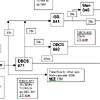
back to project page
Initial Prototype: Description
|
The initial prototype for this system was created using Crickets, a programmable brick technology developed at the MIT Media Lab. This page provides some information about how the Crickets and other devices were used to prototype a tabletop modeling toolkit in collaboration with the postal service. It also addresses the weaknesses of the Cricket system for this project. |
|
Images of Prototype
|
|||||||||
|
Overhead view of the model
|
|||||||||
|
Close-up view of the model
|
|||||||||
|
Data collection interface
|
|||||||||
|
Simulation control interface
|
|||||||||
 |
|||||||||
| USPS Mailflow diagram | |||||||||
| More information... | |||||||||
|
|||||||||
Description
The initial prototype of the Tabletop Process Modeling Toolkit consisted of a model of a section of the Boston South Station USPS mail processing facility created using the Cricket system of programmable bricks and bus devices. Each processing operation was represented by a Cricket with a colored light and a display. These Crickets are connected together by pairs of infrared transceivers with a display to indicate the quantity of mail flowing through each link. The simulation is controlled by a laptop computer, which acts as the input by delivering mail to the first processing stage. The Crickets then send messages to each other to indicate when mail is being transferred between operations to simulate the operation of the plant, as the laptop continues to inject more mail as it arrives. When all of the mail has been processed, the number of work hours, total mail processed, and start and stop times for each machine may be obtained on the laptop by bringing the infrared interface connected to the laptop next to each Cricket.
Cricket Technology
The Cricket is a small computer powered by a 9-volt battery. Two motors and two sensors may be directly connected to the Cricket, and a large library of bus devices have been created to allow the Cricket to control and obtain data from a larger family of devices. Crickets are programmed in a variant of the programming language Logo by downloading programs written on a desktop computer to the Cricket using an infrared interface plugged into the computer's serial port.
Challenges and Limitations of the Cricket System
For the prototype, we used Crickets and a number of bus devices: tri-color LED's, small two-line LCD panel displays, numeric displays, and infrared transceivers. Although the availability of these devices in the system made it possible for us to construct the prototype relatively quickly, using so many devices on each Cricket (up to three infrared transceivers and numeric displays) caused a major power drain, using up a nine-volt battery in a matter of one or two hours.
Communication, memory and processing power were our other major challenges in using the Cricket system to construct this sort of modeling toolkit. We were only able to store a limited amount of data on the Crickets, and limitations of the Cricket logo language made the programming technically difficult, but the biggest challenge was that the infrared transceivers support a very limited effective data rate. In fact, we could only reliably send a single byte between Crickets-and then only be retrying until a confirmation was received. (The problem lay in the Cricket bus protocol, which requires that the Cricket poll the infrared device to detect a received character. Polling interrupts an incoming byte that's being received at the same time because the processor gets an interrupt to handle the bus communication.) These communication difficulties prevented us from allowing the operational parameters to be directly controlled by dials on the Crickets as we had initially planned, as well as consuming a great deal of development time. Improving the communication infrastructure has been a major focus of our next stage of development.